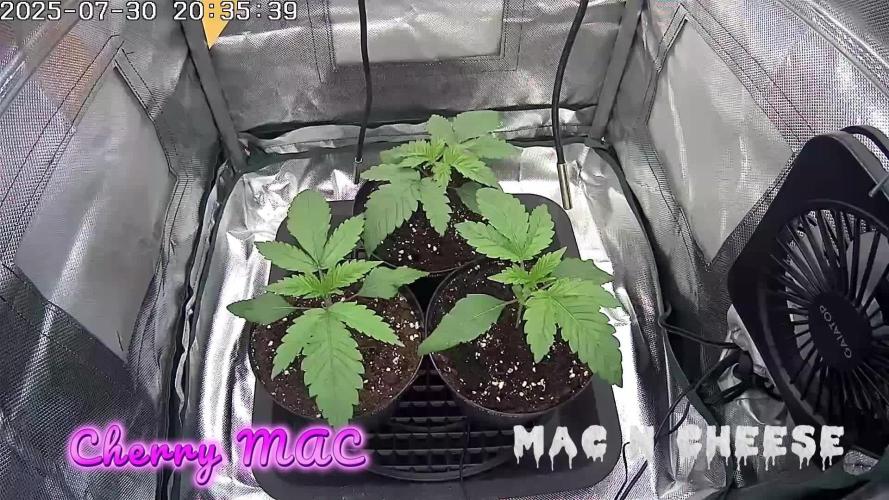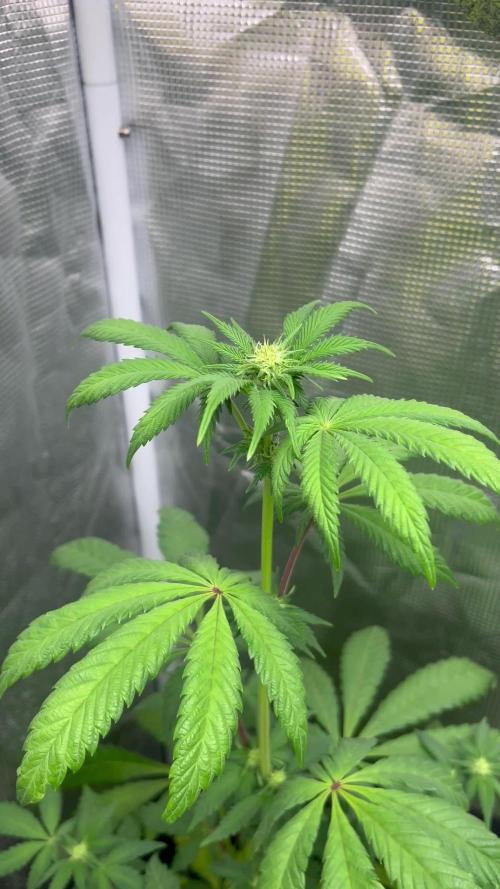The Grow Awards 2026 🏆 



































Likes
16
Share


@Canadian
Follow
This girl has been growing out of control in my tent I don't see her flowering very much not sure if she's a auto or a photo Plant i will continue to have an eye on he for now I had to tie her to a corner of the tent in order for her not to take over the entire space and is a plant that grows vigorously strong and it has a lovely smell White Widow skunk .
Thank you for reading I will continue to update have a happy grow.
Likes
11
Share


@eldruida_lamota
Follow
Que pasa familia, vamos con la séptima y última semana de floración de estas Gorilla cookies Auto de FastBuds.
Por el momento todo va bien tienen buen color, van madurando esas flores.
Llevan solo agua toda la semana.
Por supuesto el ph se mide en cada riego y se mantiene en 6.2 y riego en intervalos de 48h.
La temperatura está entorno al 22/24 grados y la humedad anda sobre el 50%.
La verdad para ser autos es que me han hasta sorprendido , buena estructura, resistentes , fáciles, huelen fuerte y están llenas de resina. Qué más puedo pedir?
Mars hydro:
Code discount: EL420
https://www.mars-hydro.com/
Agrobeta:
https://www.agrobeta.com/agrobetatiendaonline/36-abonos-canamo
Hasta aquí todo, Buenos humos 💨💨💨
Likes
7
Share


@AlpenZilla
Follow
🏆 Harvest Report – MAC n Cheese
🌱 Strain summary:
MAC n Cheese delivered a solid mid-range yield with strong structure, excellent trichome coverage, and a clean fade during flush.
📦 Dry yield:
106.97 g of trimmed, dry buds
🌿 Plant traits:
• Compact structure with a balanced canopy
• Aroma: a mix of cheesy and cookie-like notes, slightly spicy with a creamy undertone
• Flush was clean and effective – no signs of stress or imbalance
• Buds were heavy, resinous, and matured evenly across the plant
📝 Final verdict:
A reliable strain with strong visual appeal and consistent growth. Very manageable, even in the final weeks, and responded well to EC control and light defoliation.
Terp profile leans toward dessert-like funk – definitely a keeper for future runs!
💧 Grown with:
Advanced Nutrients Masterline (pH Perfect)
Plagron Lightmix / Coco (80/20 blend)
Likes
28
Share


@Trickybis82
Follow
Will grow again for sure shout out to @420fastbuds for the strain what a all round great plant!!!!
Processing
Likes
10
Share


@mkrmkr
Follow
Completing the fiveteenth week.
Plant 1 - Completing the fiveteenth week of life.
Plant 2 - Completing the fourteenth week of life.
Plant 3 - Completing the fourteenth week of life.
KeepGrowing.......!
Likes
1
Share


@Dabcik
Follow
I profumi iniziano a sentirsi forti e ben definiti! Le cime delle happy ending sembrano le più grosse e compatte e resinose al momento. Anche le pink poochie promettono bene. Le zerberry stanno mutando colore sul violaceo
Likes
26
Share


@MadeInGermany
Follow
Flowering day 59
since time change
to 12/12 h.
Hey guys :-)
The lady is slowly coming to an end 😍.
The buds start to swell extremely .
The trichomes are 80 % milky and 20 % amber :-) .
Last week she was given a very light flush with Clean Fruits so that she can use up her remaining nutrients in the coming days 👍.
It will be harvested in the next 3 - 6 days 😍.
I can't wait to try them all :-) .
Otherwise everything was cleaned and checked.
Have fun and stay healthy 💚🙏🏻
👇🏼👇🏼👇🏼👇🏼👇🏼👇🏼👇🏼👇🏼👇🏼👇🏼👇🏼👇🏼
You can buy this Nutrients at :
https://greenbuzzliquids.com/en/shop/
With the discount code: Made_in_Germany you get a discount of 15% on all products from an order value of 100 euros.
👇🏼👇🏼👇🏼👇🏼👇🏼👇🏼👇🏼👇🏼👇🏼👇🏼👇🏼👇🏼
You can buy this strain at :
https://www.exoticseed.eu/de/hanfsamen/lemon-candy
Water 💧 💧💧
Osmosis water mixed with normal water (24 hours stale that the chlorine evaporates) to 0.2 EC. Add Cal / Mag to 0.4 Ec Ph with Organic Ph - to 5.8 - 6.5
MadeInGermany
Likes
6
Share


@Dengued
Follow
Day 35....all plants in full stretch and seem to be loving the organic spirulina...im adding a tablespoon of powder per 1.5 litres...planning to only feed them spirulina till the plants tell me otherwise.
Likes
6
Share


@NootkaOG
Follow
Another week of growth in the books here. I am loving the flowers peyote forum is putting off. Starting to see some purple colours starting on these plant. Also noticing one of the plants starting to lose its colour which has me concerned as I saw some bugs on this plant a few weeks ago and sprayed for them, something to keep an eye on moving forward.
I top dressed these plants with 1 tbsp/gallon of Power Bloom and hit them with a compost tea made up of worm castings, Bokashi Pro Gro, Molasses and Bat Guano. This will be the last feeding I give these plants.
Likes
10
Share


@KushSlayer
Follow
End of the week 5 of flowering
I have little bit problems with humidity 60-70% and i found something that doesnt look like good thing in bud :( but only in one lady
Overall ladies look good only one have something going, should i start flushing?
week 6 of flowering starts today
Likes
19
Share


@eldruida_lamota
Follow
Que pasa familia, vamos con la segunda semana de floración de estas Papayton feminizadas de fastbuds.
Vamos al lío ,se trasplantaron en macetas de 7 litros definitivamente.
El ph se controla en 6.0 , la temperatura la tenemos entre 24/20 grados y la humedad ronda el 50%.
El ciclo de floración puse 12h de luz, el foco está al 50% de potencia.
De momento van creciendo a buen ritmo y tienen un buen color, estaban muy bien enraizadas al realizarle el trasplante se notaba la abundancia radicular.
COMENTAR: que una de las 3 salió macho.
Agradecer a Agrobeta por el kit Gold series que mandaron, siempre os portáis, unos maestros.
- os dejo por aquí un CÓDIGO: Eldruida
Descuento para la tienda de MARS HYDRO.
https://www.mars-hydro.com
Hasta aquí todo, Buenos humos 💨💨💨
Likes
26
Share


@HowtoBubatz
Follow
After 2 days the roof is getting of and the plant gets her first 250 ml of Water.
The plant grows very vigorously and fast. Unfortunate the last day the plant begun to bend her first 2 leaves up and i dont realy know why.
I will try something out and see where it goes.
Likes
21
Share


@HappyHarvest
Follow
We are make progress now, check out that trichome production this week. Stunning! I cleaned up the bottom one more time. I will be top dressing this next week and it will be the last before harvest.
Processing
Likes
6
Share


@Stoneman881
Follow
07.09 Today it was ready for bloom.
3 L water. pH.6.35. pic tomorrow
Likes
20
Share


@eldruida_lamota
Follow
Que pasa familia, vamos a añadir la novena semana de floración de estas Apple Fritter de RoyalQueenSeeds, empezamos con la temperatura que la tenemos entre los 21/25 grados, la humedad está entorno al 50%, el ph está en 6.2 , el foco actualmente lo tengo encendido 12 horas y la potencia es al 100% de lo que da el foco.
Las flores estan poniéndose bien guapas
Veremos como acaban estas semanas, ya les retiré el alimento y llevan una semana solo con agua.
Mars hydro:
Code discount: EL420
https://www.mars-hydro.com/
Agrobeta:
https://www.agrobeta.com/agrobetatiendaonline/36-abonos-canamo
Hasta aquí todo, Buenos humos 💨💨💨
Likes
3
Share


@Kifferluemmel
Follow
in Blütewoche 4 habe ich Komposttee zubereitet - dieser wurde 24 Stunden mit einer Pumpe belüftet. Nach 20 Stunden ist der Geruch schon recht intensiv - das kann ja nur was werden ;-) 0,75L hat jede Pflanze erhalten. Zudem wurde massiv entlaubt, untenrum und zum Mittelpunkt hin.
Likes
9
Share


@MadeInGermany
Follow
Harvest day 69
since time switch
to 12 / 12 h
Hey guys :-)
Finally it's time 💚
The lady is done the large leaves have been removed and hung upside down to dry in the dark drying room.
You can now stay there for 13-15 days at a temperature of 18-20 degrees and 55-62% humidity.
After 13-15 days it is neatly trimmed by hand and placed in jars with boveda packs 62.
After 4 weeks Boveda 58% come in and are ready for testing ;-).
After everything has been cut cleanly, the last update comes with the smoke report and the finished pictures.
Have fun and stay healthy 💚🙏🏻
👇🏼👇🏼👇🏼👇🏼👇🏼👇🏼👇🏼👇🏼👇🏼👇🏼👇🏼👇🏼
‘Powered by GreenHouse Feeding’
Copy the link for 10% off all Nutrients 👇🏼
http://shop.greenhousefeeding.com/
affiliate/madelngermany_passiongrower/
👇🏼👇🏼👇🏼👇🏼👇🏼👇🏼👇🏼👇🏼👇🏼👇🏼👇🏼👇🏼
Water 💧 💧💧
Osmosis water mixed with Cal/Mag (24 hours stale that the chlorine evaporates) to 290 ppm and Ph with Ph- to 5.8 - 6.4
MadeInGermany
Likes
48
Share


@MANIIAKSINDUBS
Follow
She's starting to smell up nice upped her bloom n top max up tied down 3 more branches






















